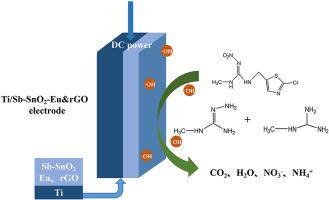Chemosphere ( IF 8.8 ) Pub Date : 2020-11-28 , DOI: 10.1016/j.chemosphere.2020.129126 Dan Guo , Yongbo Guo , Yixuan Huang , Yongyang Chen , Xiaochun Dong , Hao Chen , Shanping Li

|
This work investigated the preparation of Ti/Sb-SnO2 electrode co-doped with graphene and europium and the electrochemical degradation of clothianidin in aqueous solution with Ti/Sb-SnO2-Eu&rGO electrode. The physicochemical properties of different electrodes were characterized by using the scanning electron microscopy, X-ray diffraction, oxygen evolution potential and cyclic voltammetry tests. The results indicated that the Ti/Sb-SnO2-Eu&rGO electrodes have a compact structure and fine grain size and have a higher oxygen evolution overpotential than Ti/Sb-SnO2-None, Ti/Sb-SnO2-Eu and Ti/Sb-SnO2-rGO electrodes. Among the four electrodes, the Ti/Sb-SnO2-Eu&rGO electrode showed the highest efficiency and was chosen as the experimental electrode. The main influence factors on the degradation of clothianidin, such as initial pH, electrolyte concentration, current density and initial concentration of clothianidin, were analyzed. The results showed that the removal rate of clothianidin can reach 96.44% under the optimal conditions for 120 min treatment. Moreover, a possible degradation pathway including the fracture of internal bonds of clothianidin such as the N-N bond, the C-N bond that connects nitroguanidine to the thiazole ring and mineralization was elucidated by intermediate products identified by HPLC-MS method and Fourier transform infrared spectroscopy (FTIR). This paper introduces the Ti/Sb-SnO2-Eu&rGO electrode into an electrocatalytic degradation system and could provide basic data and technique support and guidance for the clothianidin wastewater pollution control.
中文翻译:

Ti / Sb-SnO 2 -Eu&rGO电极的制备及其电化学处理可尼丁废水的降解
这项工作研究了与石墨烯和euro共掺杂的Ti / Sb-SnO 2电极的制备,以及Ti / Sb-SnO 2 -Eu&rGO电极在水溶液中可尼丁的电化学降解。通过扫描电子显微镜,X射线衍射,析氧势和循环伏安法测试表征了不同电极的理化性质。结果表明,Ti / Sb-SnO 2 -Eu&rGO电极具有致密的结构和良好的晶粒尺寸,并且比Ti / Sb-SnO 2 -None,Ti / Sb-SnO 2 -Eu和Ti /具有更高的氧释放超电势。Sb-SnO 2 -rGO电极。在四个电极中,Ti / Sb-SnO 2-Eu&rGO电极效率最高,被选为实验电极。分析了影响可尼丁的降解的主要因素,如初始pH,电解质浓度,电流密度和可尼丁的初始浓度。结果表明,在120 min最佳处理条件下,可尼丁的去除率可达96.44%。此外,通过HPLC-MS方法和傅里叶变换红外光谱(FTIR)鉴定的中间产物阐明了可能的降解途径,包括可尼丁苷的内部键断裂,如NN键,将硝基胍连接到噻唑环的CN键和矿化。 )。本文介绍了Ti / Sb-SnO 2-Eu&rGO电极进入电催化降解系统,可为可比丁废水的污染控制提供基础数据和技术支持与指导。



























 京公网安备 11010802027423号
京公网安备 11010802027423号